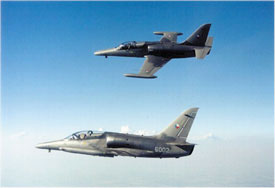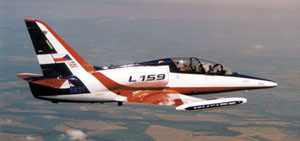|
The Czech Republic has a tremendous pedigree in the production of jet
trainer aircraft, that stretches back over 40 years. Czech aircraft
designers and engineers first produced flying machines in the years
after World War II but it was only in the 1960s that the world began
to see the fruits of their labours when the first of more than 6,000
fast jet trainers rolled off Aero Vodochody's production lines for
Warsaw Pact air forces and export customers.

In the early 1960s the then Soviet Union was
looking for a basic jet trainer. Designs were submitted from the
various Warsaw pact countries. The Poles proposed the TS-11 Iskra
(still flying with the Polish and Indian Air Forces), Czechoslovakia
the L-29 Delfin, and Russia the YAK 30. The Czechs won with the L-29
and the first production aircraft was delivered in April 1963. In
addition to the standard model, two others were produced in small
numbers, the L-29R, available with nose cameras and under-wing stores,
and the L-29A,
the single seat aerobatic version.
Altogether, about 3,600 aircraft were completed by
the time production at Aero's Vodochody plant near Prague ceased in
1974. Approximately 3,000 were delivered to the Soviet Union while
other customers included the Czech Air Force, the German Democratic
Republic, Romania, Syria, Bulgaria, Hungary, Egypt, Indonesia,
Nigeria, Uganda and Iraq.
The L-29 was of a totally new design as it had a
tandem seating position and a straight wing chosen with the best wing
for subsonic flight. The fuselage had a single engine with an air
intake in each wing root. This was mounted about mid way and towards
the rear of the wing. The Motorlet M-701c-500 turbojet rate was at
1,960 lbs. thrust. The M-701 was an early generation jet engine and
featured a single stage centrifugal compressor driven by a single
stage axial flow turbine. 100 per cent RPM is 15,300 which gives a
whistling sound similar to the Fouger Magister of similar vintage.
Albatross

The L-39 Albatross succeeded the L-29 Maya/Delfin. The L-39 basic and
advanced jet trainer first flew on 4 November 1968. They were followed
by ten pre-production aircraft. It was the standard jet trainer for
the Soviet Union and Czechoslavakia from 1971 to 1973. Some 3,000 have
been produced and the aircraft is the standard jet trainer for former
Warsaw Pact countries. Recipients of these aircraft also included
Afghanistan, Algeria, Bulgaria, Cuba, Ethiopia, Iraq, Libya, Nigeria,
Romania, Syria and Vietnam. Over the years several different versions
were built:
L 39C: Standard aircraft for basic and
advanced training.
L 39V: Single-seat aircraft for target
towing. Used by Czech and East German air forces. Only eight were
built.
L 39ZO: Training and multi-purpose light
attack aircraft with under-fuselage gun pod and four hardpoints under
the reinforced wing. First flown on 25 August 1975.
L 39ZA: Trainer and light attack aircraft
with improved avionics. First flown in September 1976. This version
remains on offer.
L 39ZA/ART: Version for Thailand with the
avionics supplied by Elbit of Israel. On the basis of the L-39, Aero
developed the L-139 trainer with Allied Signal TFE731 engine and
digital avionics as well as the L-59 with the DV-2 powerplant. The
latest version is the L-159 light attack aircraft for the Czech Air
Force, which began flying in August 1997.
Boeing link

In 1997 a joint venture team, composed of Boeing Commercial Airplane
Group, McDonnell Douglas Aerospace and CSA Czech Airlines, was
selected to become a strategic partner with Aero Vodochody.
Boeing was successful in tendering to acquire 35
per cent of Aero Vodochody. "We're delighted that our team has been
selected," said Catherine 'Willie' Pepper, project manager of the
joint venture for Boeing Enterprises. "We were confident that our
offer was competitive, and we are looking forward to working with Aero
Vodochody and its highly skilled and educated work force. The
combination of
Aero Vodochody's technical capability and manufacturing expertise, as
well as the strengths of Boeing, McDonnell Douglas and CSA will make
for an exciting business opportunity and, we believe, an excellent
investment."
The main purpose of the link-up with Boeing was to
bring in western capital and expertise in order to westernise the
L-159 to ensure its export potential. To introduce it to the global
market, L-159 had to meet the latest quality, mil-spec and NATO
standards. The aircraft features western avionics, with an Allied
Signal F124-GA-100 turbofan and can be armed with a wide range of
western produced air-to-air and air-to-ground smart ordnance.
In production
The L-159 advanced subsonic jet trainer and light
attack fighter is currently in full production at Aero Vodochody's
facility on the outskirts of Prague. The company says it is dedicated
to providing genuine customer value and is continuously involved in
quality improvements and the promulgation of 'lean' processes to make
its range of products even more competitive and attractively-priced.

"We will
endlessly pursue improvements and eliminate non-value added tasks to
provide our customers with the performance and quality they expect at
prices that no one can approximate, thereby earning the trust and
confidence of the user community. In this way, we will always be able
to demonstrate best value in the eyes of the customer, which in the
final analysis is everything" stated Aero's president and chairman of
the board, Peter Hora.
In April 2000 the first L-159 was delivered to the
Czech Air Force at the ACR tactical air force base in Cáslav where
they were to be tested in operation. General Sedivy, Chief of the
General Staff, General Kl'ma, Air Force Commander, and other
representatives of the armed forces, local authorities and the
producer participated in a ceremony to mark the event. Practical
training of pilots for the L-159 had already started in mid-January
2000. The L 159 was introduced to a wider audience at the June 1999
Paris and July 2000 Farnborough air shows. To date the Czech Air Force
has agreed to buy 72 L-159 light combat aircraft for a total sum
exceeding CZK 30 billion.
AE 270
The first flying prototype of Aero Vodochody's Ae
270 Ibis utility aircraft was dispatched to VZLÚ (Aeronautical
Research and Tests Institute) in Letnany not long after Aero's initial
test flights. It underwent first stage ground testing during which the
frequency responses of the frame were carefully documented.
The aircraft's horizontal tail surfaces and rudder
static strength tests were also successfully carried out at VZLÚ. The
Aeronautical Institute of the mechanical engineering faculty, Brno
University laboratories participated in successfully testing the
engine bed and in taking the drive unit gripping stiffness
measurements. The Ae 270 turboprop aircraft recently made its first
flight in the Czech Republic.
L159 ALCA
Advanced light combat aircraft
L159A - single seat light multi-role combat
version
L159B - two seat light combat/lead-in trainer version
Main features: Latest generation Allied
Signal/ITEC F124-GA-100 turbofan engine
Seven pylons - six under wing and one under the fuselage centreline
head-up display, head-down displays, multi mode pulse doppler radar
Radar warning receiver and countermeasures dispensers
HOTAS Controls
OBOGS (on-board oxygen generating system), OBIGGS (fuel tanks inerting
system)
APU, 0-0 ejection seat
Performance: Max. level speed 935 km/hr
Max. rate of climb 48 m/s
Load factor +8g/-4g
Max. ramp weight 8,000kg
Service ceiling 13,200 m
Internal fuel 1,551 kg
Total fuel (int.+4 x ext.) 2,875 kg
Max. range (int. fuel only) 1,570 km
Max. range (int., ext. fuel) 2,530 km
|
